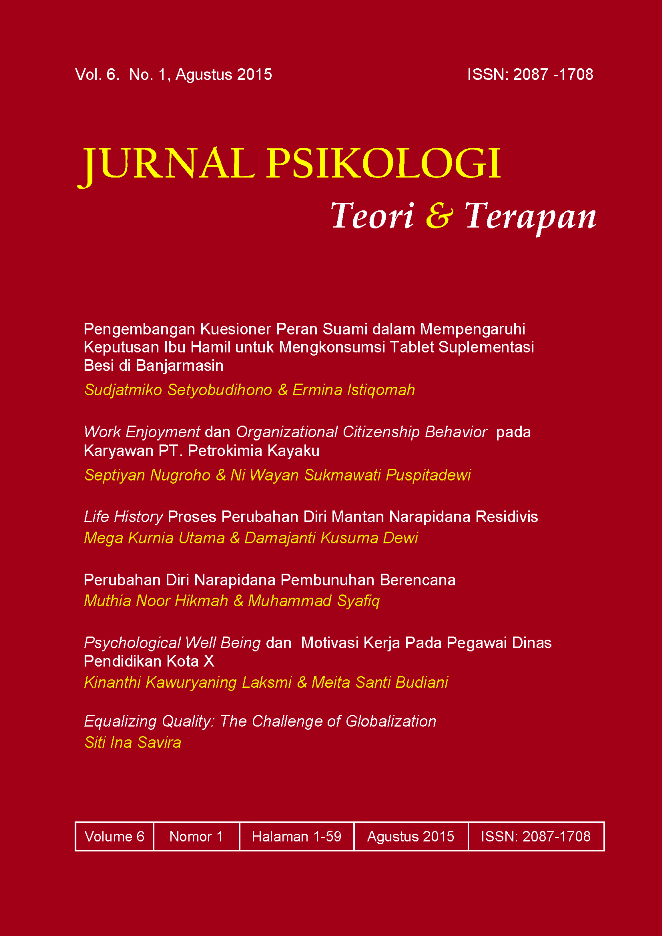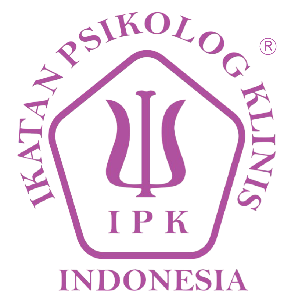Life History Proses Perubahan Diri Mantan Narapidana Residivis
DOI:
https://doi.org/10.26740/jptt.v6n1.p18-34Keywords:
Perubahan diri, mantan narapidana residivisAbstract
The processs of changes among ex-recidivist convict is interesting issues in terms of how they face problems of living with society that impact on self-change. The purpose of this study was to explore the experience of an ex-recidivist convict in struggling to reintegrate into society. This research used qualitative approach with life-history method. One participant who is an ex-recidivist convict and two significant others were involved in this study. Data collected using semi-structured interviews and analyzed using narrative analysis. This study reveals 4 (four) major themes, the participants life before his change, the participants self-transformation, the ways he takes to face the obstacles of change and social context of the changing process. In general, the result of this study shows that the participant has succeeded his changing process which is signed by the fact that he does not do any criminal acts or another negative behaviour anymore. The self-changing has been increased by the participant through his efforts to change his surrounding environment into the better condition.
Abstrak: Penelitian ini dilatarbelakangi oleh bagaimana proses perubahan mantan narapidana residivis baik dari segi permasalahan yang muncul serta dampak perubahan diri pada individu. Penelitian bertujuan mengungkap bagaimana pengalaman partisipan terkait proses perubahan, cara partisipan dalam menghadapi hambatan, serta keadaan lingkungan sosial pada proses perubahan. Penelitian menggunakan pendekatan kualitatif dengan metode life history dengan analisis data naratif. Pengambilan data menggunakan metode wawancara semi-tersturktur yang terdiri dari 1 partisipan inti dan 2 orang significant other. Peneltian menghasilkan 4 tema besar yaitu kehidupan partisipan sebelum berubah, proses perubahan diri, cara menghadapi hambatan, kondisi lingkungan sosial dalam proses perubahan. Hasil secara umum menunjukkan bahwa partisipan berhasil dalam proses perubahannya yang ditandai tidak kembali melakukan tindakan kriminal ataupun perilaku negatif lainnya. Perubahan diri juga partisipan tingkatkan dengan usahanya dalam mengubah lingkungan.
References
Direktorat Jenderal Pemasyarakatan. (2014). Ditjen PAS - SMS Gateway System. Online smslap.ditjenpas.go.id. Diakses 20 Desember 2014
Jones, C. M. (2005). Genetic and Environmental Influences on Criminal Behavior. Personality Papers. Online. http://www.personalityresearch.org. Diakses 17 Agustus 2014
Lamley, C. K., & Mitchell, R. W. (2012). Narrative Inquiry: Stories Lived, Stories Told. In S. D. Lapan, M. T. Quartaroli, & F. J. Riemer, (Eds.), Qualitative Research. An Introduction to Methods and Designs. Research Methods for the Social Sciences (pp. 243-270). San Fransisco: Jossey-Bass.
Lee, T. (2012). Recidivism Hard To Shake For Ex-Offenders Returning Home To Dim Prospects. Online. http://www.huffingtonpost.com. Diakses 30 Desember 2014
Lubkin, I. M., & Larsen, P. D. (2006). Chronic Illness: Impact and Interventions (6th ed.). London: Jones And Bartlett Publishers.
Muhlausen, D. B. (2010). The Second Chance Act: More Evaluations of Effectiveness Needed. Online. http://www.heritage.org. Diakses 30 Desember 2014.
Nsanze, C. F. (2007). The Ex-prisoners Transition Processes Into Society. Disertasi. University Of Göteborg: Gothenburg. Online. https://gupea.ub.gu.se. Diakses 30 Desember 2014.
Nuraini, A., & Ahmadi, D. (2005). Teori Penjulukan. MediaTor, 6 (2), 297-303. Online. download.portalgaruda.org. Diakses 20 November 2014
Olson, J. M. (1992). Psychological Barriers to Behavior Change. Canadian Family Physician , 38 (1), 309-3019. Online. https://www.ncbi.nlm.nih.gov. Diakses 20 November 2014
Prochaska, J. O., DiClemente, C. C., & Nocross, J. C. (1992). In Search of How People Change. American Psychologist , 47 (9), 1102-1112. Online. https://www.ncbi.nlm.nih.gov. Diakses 20 November 2014
Russell, J., & Russell, L. (2006). Change Basics. Alexandria: ASTD Press.
Downloads
Published
How to Cite
Issue
Section
License
Authors who publish in this journal agree to the following terms:
Copyright in any article is held by the author.
The author grants the journal, publication rights with the work simultaneously licensed under a Creative Commons Attribution License that allows others to share the work with an acknowledgment of the work's authorship and initial publication in this journal.
Authors may enter into separate, additional contractual arrangements for the non-exclusive distribution of the journal's published version of the work (e.g., posting it to an institutional repository or publishing it in a book), with an acknowledgment of its initial publication in this journal.
Authors are permitted and encouraged to post their work online (e.g., in an institutional repository or on their website) prior to and during the submission process, as this can lead to productive exchanges, as well as earlier and greater citation of published work.
 Abstract views: 2122
,
Abstract views: 2122
, PDF Downloads: 2142
PDF Downloads: 2142


















